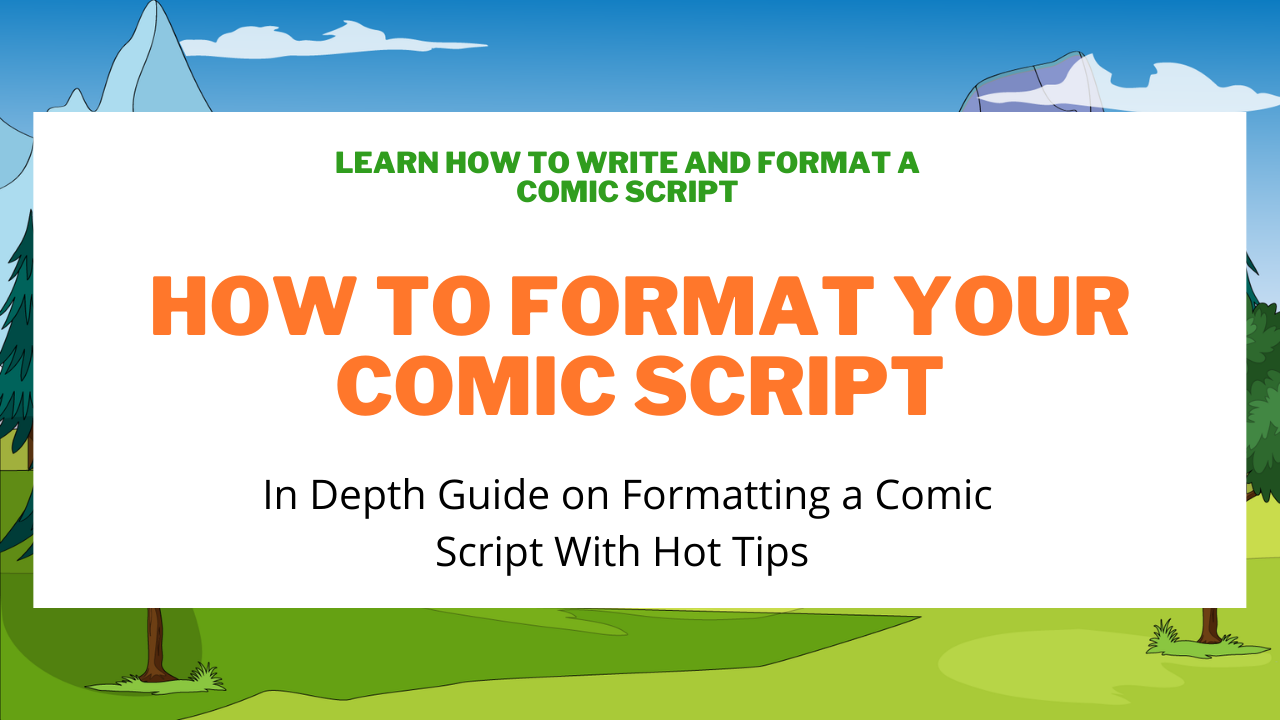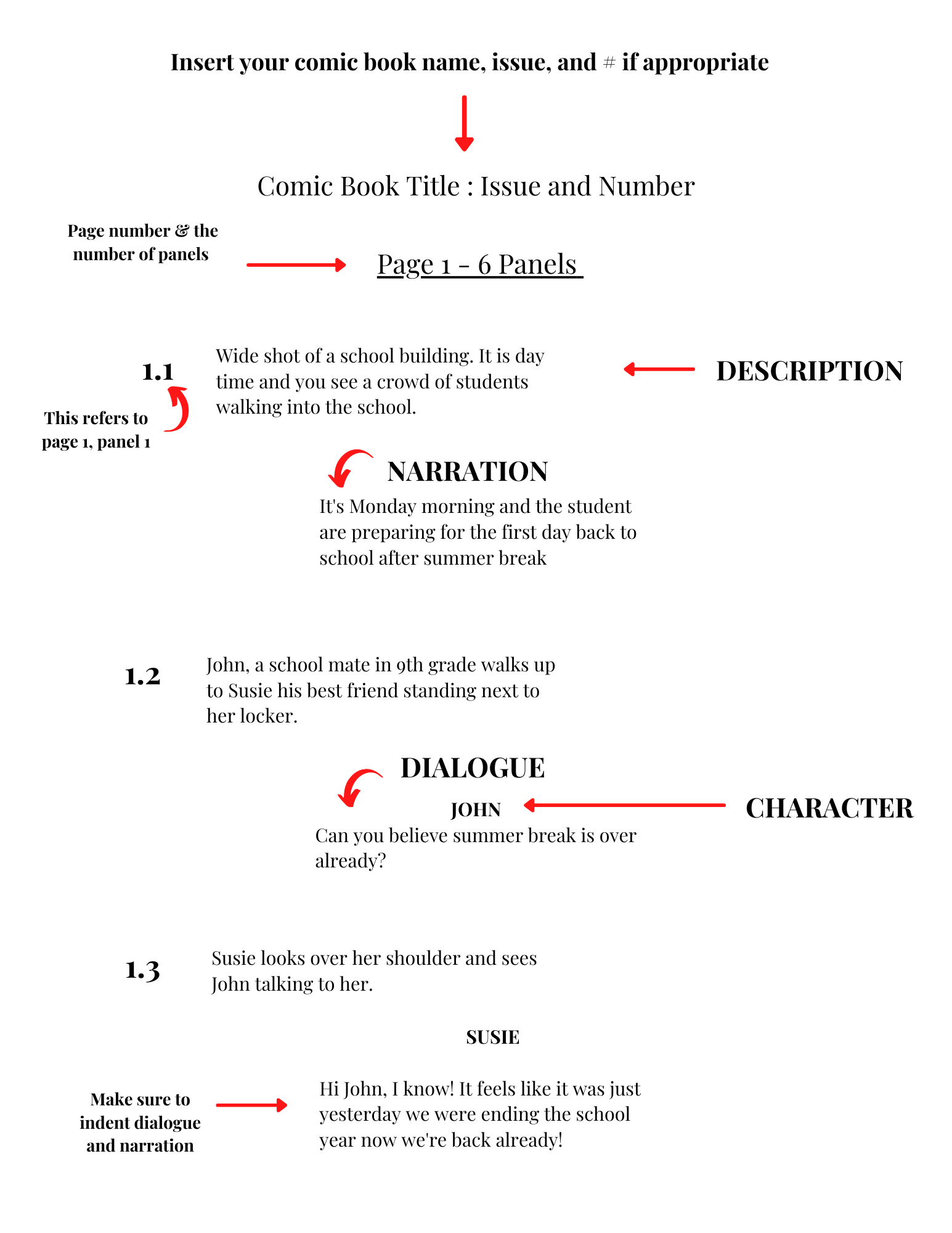Comic Script Format: How to Write Your Comic Script
Okay, you have a great comic book idea in mind, but how do you create a comic script format? There is no right or wrong way to write a comic book script, but there are guidelines to consider that will make it easier to develop into a comic book.
When creating your comic book script, formatting is a crucial step in the process. It helps you organize your story and provide a clear reference when turning your script into a comic book. Also, by mapping out your character's dialogue and narration it will help you create a smooth storyline that hooks your readers in and keeps them reading.
Ready to learn how to create a great comic script? Check out our guidelines below!
Before Writing Your Comic Script Outline Your Story
Before you start writing your comic script, you should outline your story.
Creating an outline will help you map out your story's major plot points and give you insight on how you will depict it to your readers, either through narration, character dialogue, or both.
Knowing the key points and the actions that lead to them will help you decide what information needs to be in the script. You don’t want to leave readers confused, so making sure to clearly outline what happens before, during, and after the climax of your story will help you determine what information is relevant and what can be left out.
Tips For Proper Comic Script Formatting
Whether you are creating the comic book yourself or collaborating with an artist, having proper script formatting will make developing your comic book easier because you will be able to envision your story as a whole before drawing it.
Take a look at our example below:
Make sure to keep track of your pages by numbering each one and assigning a panel. You will see above 1.1 refers to page 1, panel 1.
You will also need to think about the transitions in your story. Are there any hard breaks between scenes? Are there multiple characters you need to introduce? Formatting your script to include panel descriptions, characters, dialogues, and narration will help you stay organized and recall what needs to be included in the comic when it's time to draw (or not draw)
This format is also efficient because it is CLEAR. Having clarity when taking your comic book from script to development will make it easier when creating the panels. The artist (or you) won’t have to guess what to draw because you will have clear descriptions organized in the script format.
Script writing is most successful if it is easily understood. In the example above - you can tell what's dialogue and what's narration just by the way it's formatted.
Remember - your script is not the final product, it's merely the vessel to get you to the end result - a finished comic book with artwork, pages, and a great story (Need story ideas? Check out this article)
Comic Script Format: Writing Basics
Don’t overload with descriptions. Creating lengthy descriptions for each panel can bog down your story. Think about your comic from the reader's perspective. Do they need to know every detail about the setting, scene, or environment? Probably not. Only include what is necessary to the story.
Consider how many panels you will have on each page. We discussed earlier how outlining your story can help you stay organized when writing your script. Sticking to scripting the predetermined events from your outline will keep you on track and prevent the script (and thus comic book) from getting off-track.
Know what will be dialogue and what will be narration. Create sections for each panel to help you map out what needs to go in each one. Use the template above to help you draft out your comic script and align your panels to text.
🔥HOT TIP🔥 How to determine the number of panels to put on a page for maximum effect!
To determine how many panels you should have per page, look at the amount of text needed to accompany each panel. If you have a lot of narration, dialogue, and description, go for fewer panels per page so that you avoid overcrowding images with text.
Plot First vs. Full Comic Script Writing
Plot first scriptwriting is when the author writes the story and lets the artist decide panel breakdown. Full comic scriptwriting is when the author writes the story AND the panel descriptions for the artist.
When you use plot-first script writing, you focus more on the plot and writing the story. Your artist will be in control of composing your comic, creating panels FOR you in the way they best see your tale playing out. Because comic books are essentially a collection of panels and pages, this writing process also gives the artist control over the pacing of your comic book. After the artist creates the panels, you would then go in and add narration and dialogue.
One downside to this script writing format is that your artist might translate your story differently than you. So your pacing or composition might be skewed.
Full script writing gives you more control over how the comic panels are laid out. You will create the panel description for the artist, and they will use your descriptions to create the artwork. Using this format gives you a say in the layout and pacing, however, you may still be surprised by what/how the artist draws.
When you use Storyspread’s free online comic maker - you are both the author and the artist! You create the layout using our premade templates, settings, and characters. Use our easy drag-and-drop feature to add text boxes for narration and dialogue.
🔥HOT TIP:🔥When to use plot first vs. full comic script format
Use plot first comic script format if you trust your artist and are okay letting them develop your layout and panel pacing.
Use full comic script format if you have a clear vision for your comic book and want to make sure your panels match the layout you envision.
Review, Revise, and Edit.
Make sure to review your comic script to see if you need to re-write, edit, or add context to your comic. It’s typical to have many drafts of your comic book, so don’t be afraid to revise sections.
A great way to see if your comic script flows is to read your comic aloud. Hearing how your story sounds will help you consume your story from a reader's perspective. Does the narrator give the reader everything they need to understand the plot? Does the dialogue between the characters make sense? Is your narration comprehensive? Answering these questions when writing your script will ensure your plot and storyline is complete.
Comic Script Format Final Thoughts
As we mentioned above, there is no wrong or right way to format your comic strip, but the most important thing is to start your comic. It is common to become overwhelmed with the process, give up, or worse, never start.
If you’re not an artist but have a vision for your comic book, use Storyspread to create your comic, graphic novel, or storyboard! We make it easy for you to create a comic online with our free online comic bookmaker that gives your access to drag-and-drop features to bring your story to life!
Creating your comic book has never been easier with our friendly software - and no drawing is required!!
Hi, Welcome to Storyspread.com!
Comic creation made simple. Create graphic novels with a single click. Add character, backgrounds, and more.
Easy to use. Say goodbye to searching far & wide for an expensive illustrator.
Tell your story. Join other creatives, readers, and hobbyist in producing high quality & beautiful comics
Read. Read other’s comics for FREE and share with others
Grow. Grow an audience you love with the stories YOU imagined
Were you can create a comic and graphic novel WITHOUT drawing. Simple and easy! Made for all skill levels. Click-n-drag comic book characters, scences into panels.
Create a comic just like this! Here.





